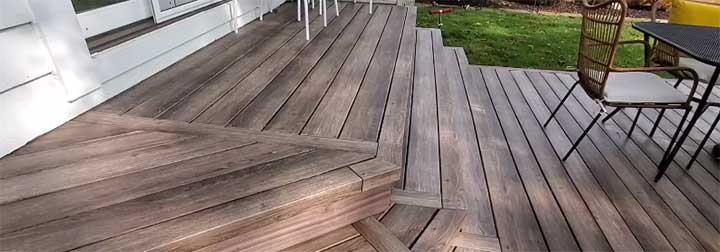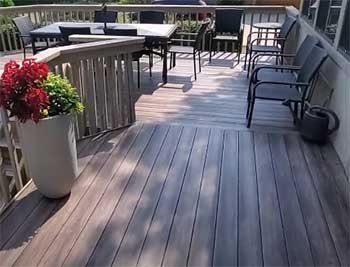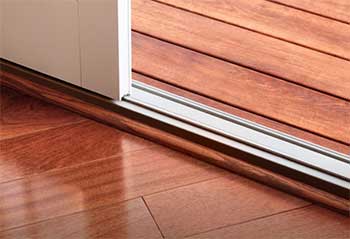Zuri decking has become increasingly popular in recent years as a low-maintenance and durable alternative to traditional wood decking. However, like any building material, Zuri decking is not without its potential problems.
In this article, we’ll take an in-depth look at some of the most common issues that can arise with Zuri decking and how to address them. From minor cosmetic flaws to more serious structural failures, we’ve got you covered on the key problems to watch out for with this unique decking material.
Problems With Zuri Decking

- Fading/Discoloration
One of the most frustrating issues homeowners can encounter with Zuri decking is fading or discoloration of the deck boards over time. When new, Zuri decking features rich, saturated colors that can range from warm natural wood tones to grays and exotic tropical hardwood colors.
But after exposure to the elements, many Zuri deck owners start to notice their decking losing its luster and vibrancy.
The culprit is usually sun exposure. Like other composite decking products, the plastic polymers and mineral streaking agents in Zuri decking can break down gradually with prolonged UV radiation from sunlight. This causes the color pigments to literally fade out of the deck boards over the course of a few seasons.
While fading is mostly a cosmetic concern, it can be disheartening for homeowners who invested in richly colored Zuri decking for its aesthetic appeal. The good news is that fading can be dramatically reduced by applying protective semi-transparent deck stains to Zuri decking soon after installation.
Quality penetrating stains contain UV-inhibitors that reflect sunlight and prevent pigment degradation within the deck boards. Reapplication every 1-2 years will maintain protection and keep your deck looking freshly stained.
For boards that have already started to fade, power washing and re-staining is the best remedy to restore color. Be sure to use a deck-safe cleaner without bleach when power washing to avoid further color loss.
Zuri also sells touch-up markers to help conceal small faded areas between re-staining. Proper stain maintenance is crucial for getting the longest lasting vibrancy from your Zuri decking.
- Mold/Mildew Growth
Another common aesthetic complaint with Zuri decking is the development of surface mold, mildew, and algae growth over time. While composite decking is touted as low-maintenance, it’s not immune from biological growth.
Just like natural wood, Zuri decking installed outdoors is vulnerable to accumulating mold, mildew, and algae, especially in shaded or wet areas.
What starts as tiny black spots can eventually grow into large swaths of black, green, or brown discoloration across the deck’s surface. This not only looks unattractive but can create a slippery walking surface.
The main factors that promote biological growth on Zuri decking are moisture, shade, poor ventilation, dirt/debris accumulation, and inadequate cleaning. Steps to reduce mold and mildew include:
- Installing the deck in direct sunlight whenever possible
- Allowing for sufficient airflow under and around the deck
- Keeping the decking free of dirt, leaves, pollen to prevent spore nutrition
- Periodic power washing to remove growth and disinfect decking
- Applying a mold/mildew-inhibiting deck cleaner monthly or as needed
- Re-staining the deck with a mold-inhibiting stain formula
Addressing moisture and shaded areas are also key for long-term mold prevention. While Zuri decking won’t rot like wood, keeping the surface clean and dry is still important for aesthetics and safety.
- Heat Buildup
A hidden downside of Zuri’s durability is the potential for excessive heat buildup on hot sunny days. The dense compressed composition of Zuri decking absorbs heat readily compared to wood.
On bare feet, surface temperatures can easily exceed over 140°F in direct strong sunlight. This can make walking barefoot on your Zuri deck uncomfortable or even dangerous for pets and children.
Fortunately, there are a few ways to counteract the heat issue:

- Install a shade structure or retractable awning over part of the deck to provide refuge
- Use strategically placed planters, pots, and vegetation to add shade
- Opt for a lighter color Zuri decking to minimize heat absorption
- Apply special reflective cool deck coatings to repel sunlight
- Mist/wet deck surface to provide evaporative cooling effect
- Put down outdoor rugs or runners to provide cooler footpaths
- Wear shoes, sandals or flip flops when walking on very hot decks
Proper airflow under the deck is also paramount to allow heat ventilation and prevent a complete hot box effect. Consider these heat mitigation strategies especially if your Zuri deck will get long daily sun exposure.
- Scratching
Zuri decking is touted as highly scratch-resistant thanks to the mineral streaking used in the outer shell. But despite its durability, Zuri decking can still get scratched from sharp objects like unprotected outdoor furniture legs, high heeled shoes, dragging hoses, construction tools, pets claws, and harsh mechanical cleaning.
Most light surface scratches are only visual and will fade and blend over time. But deeper scratches can become channels for dirt and water ingress, potentially leading to further degradation or even structural issues.
Here are some tips to minimize scratching on your Zuri deck:
- Inspect the bottom of deck furniture to ensure protective caps cover all legs, bolts, etc.
- Consider using outdoor furniture pads underneath to disperse weight
- Discourage high heels that concentrate force onto a small point
- Install scratch-resistant decking around high traffic cooking/dining areas
- Sweep debris frequently to avoid abrasion from foot traffic
- Keep pets nails trimmed to reduce claws scratching the surface
- Use bristle brushes, not stiff-bristled brushes or abrasive pads for cleaning
- Refrain from using metal shovels or sharp tools on the deck
While Zuri is more scratch-resistant than wood or composite, it still requires some basic precautions to keep the surface blemish-free. Address scratches early on to prevent exacerbating the damage.
- Peeling/Flaking
In rare cases, Zuri decking may start exhibiting surface deterioration where the outer plastic shell begins peeling or flaking off. This results in a mottled, inconsistent appearance across affected deck boards.
While the manufacturers stand behind Zuri decking durability, several factors can contribute to premature peeling and flaking:
- Sun damage – Long-term UV exposure can degrade the polymers in the outer shell over time. Ensure proper staining.
- Sub-structure Movement – Shifting deck footers underneath can flex boards excessively and compromise bonding. Ensure footers are solid.
- Improper Gapping – Lack of adequate spacing between deck boards restricts thermal expansion, causing buckling and separation of the shell. Maintain 1/4″ gaps.
- Excess Moisture – Water pooling under the deck can accelerate deterioration of the bonding agents between layers. Improve drainage and ventilation.
- Defective Product – Occasional manufacturing defects lead to premature failure. Check for warranty coverage.
- Harsh Mechanical Damage – Excessive point loads and abrasion damages protective outer shell. Avoid gouging surface.
While rare, peeling and flaking merits contacting the manufacturer right away for possible warranty replacement. It’s also wise to correct any underlying factors like poor drainage that could further compromise decking.
- Corrosion of Fasteners
An important maintenance aspect of Zuri decking is monitoring the corrosion-resistance of the hidden fasteners and hardware. While Zuri decking itself is highly water-resistant, the screws and metal clips can still be vulnerable to rust and deterioration over the long term, especially in wet environments.
The main trouble signs include:
- Visible rust bleeding through screw holes on decking surface
- Zuri boards feeling loose and unstable underfoot
- Spongy areas or depressions where fastener corrosion has occurred
- Creaking/popping sounds when walking on deck
To reduce fastener corrosion risks:
- Use quality stainless steel fasteners with anti-corrosive coatings
- Pre-drill Zuri decking holes to allow water drainage
- Apply silicone sealant around all screw holes during installation
- Avoid submerging decking in puddles or standing water
- Inspect under-deck fasteners yearly for rust problems
Replacing corroded deck screws and hardware is recommended to restore structural integrity. Prevention is also key by using proper installation methods that limit water exposure around fastener penetration points.
- Debris Staining
Zuri decking’s variegated mineral streaking pattern also makes it prone to stubborn staining from rust, leaf tannins, and other debris. Rust stains in particular from metal objects left on the deck can be extremely difficult to remove once set.
Leaf tannins from overhanging trees can also cause unsightly blackish brown stains as particles seep into the decking grain.
Here are some tips to avoid stubborn debris stains on Zuri decking:
- Don’t leave metal objects like tools, planters, furniture on the deck when wet
- Frequently clean pollen, leaves, and other organic debris
- Apply bimonthly deck sealer to help repel staining
- Cover decking below overhanging trees prone to leaf litter
For existing stains, repeated cleaning with oxalic or phosphoric acid deck brighteners may lift the pigmentation. But avoidance is a better policy, since weathering and sun exposure tend to gradually mask rather than eliminate deeply set stains. Keeping Zuri decking free of metal objects and tree litter will go far to maintain its uniform beauty.
- Splitting/Cracking
In very cold climates, Zuri decking does carry a moderate risk of developing surface splits and cracks from freeze-thaw cycles. The composition can contract enough in winter to cause fractures if the decking is unprotected. These appear as thin fissures across the length of deck boards, usually only splitting the outer shell.
To minimize winter cracking and splits:
- Allow ample room for expansion/contraction in installation gap spacing
- Avoid framing patterns that rigidly restrain board movement
- Seal all cut deck board ends with wax to prevent moisture wicking
- Keep the decking clear of snow buildup, which can freeze and expand into cracks
- Install boards later in season after threat of hard freezes has passed
Full cracking through the core of Zuri decking is rare with proper gapping. But even partial surface splits can allow water intrusion and other problems. Best practice is to inspect for cracks in spring and fill them with a flexible sealant before the rainy season arrives to limit water damage.
- Food/Drink Staining

Staining from food, drinks, grease, and grilling is a notorious nuisance on most types of decking.
Zuri’s multi-colored variegations tend to highlight oil and tannin-based stains from spills and drips during outdoor dining and entertaining.
Once soaked into the decking grain, substances like wine, coffee, cooking oils, and citrus juices can permanently discolor Zuri’s decorative pattern.
Avoiding spills in the first place is key for stain prevention:
- Use outdoor runners or rugs in dining/grilling areas
- Promptly clean any food or drink spills as soon as possible
- Apply a protective sealer to the decking for added repellency
- Cover decking below spotted ceiling treatments or lighting
- Exercise caution when carrying open glasses, bottles or pots
For existing oil-based stains, degreasing cleaners help break down and lift some pigmentation. But full removal is difficult once deeply absorbed. The best defense is creating good spill habits and reacting quickly when accidents happen before staining sets in.
- Efflorescence
Efflorescence is a crystalline, white powdery deposit that can emerge on any cement-based building material from natural mineral leaching. Zuri decking’s composition makes it susceptible to minor efflorescence blooms, especially when brand new.
While harmless, this white chalky buildup can be unsightly on the deck surface. Efflorescence on Zuri decking usually originates from water exposure leaching excess salts and calcium hydroxide from within the composite.
To reduce potential efflorescence:
- Allow adequate dry time for fresh decking before washing
- Use boiling water to activate leaching before installation
- Limit water pooling on the deck from sprinklers, furniture, planters
- Improve drainage and irrigation spray away from decking
- Prioritize rain protection and ventilation in covered areas
For existing efflorescence, washing with white vinegar helps dissolve the deposits. But avoidance is the best solution, since efflorescence can slowly reemerge over time if the source salts and moisture aren’t addressed. Letting Zuri decking fully cure and dry out before exposure to water minimizes leaching.
Conclusion
Zuri decking delivers outstanding advantages but still requires some maintenance and care to get the longest life and enjoyment from your investment. Following the tips in this article will help you prevent or resolve the most common aesthetic and durability issues with Zuri decking.
Pay special attention to proper installation, moisture management, and cleaning habits. With proactive prevention and prompt troubleshooting, Zuri’s famous longevity and captivating appearance will add beauty to your outdoor living space for decades to come.
